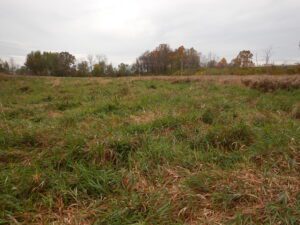
Invasive Species Awareness Week- Cattail
February 29, 2024
Celebrating the Canada Goose- And Politely Asking it to Move Along
April 22, 2024By: Cody Wright
March 3, 2022
One NNIS that doesn’t get quite enough attention is Reed Canary Grass (Phalaris arundinacea). Beginning in the 1800s, this grass has been widely used as livestock forage, for erosion control, and in landscaping. Reed Canary Grass (RCG) prefers moist, poorly-drained soils but can be found thriving in various types of habitats. From standing water to dry upland areas, this plant is highly adaptable. This adaptability, along with the production of easily dispersed seed and dense biomass via rhizomes, is what gives this plant it’s invasive nature.
While it has been determined that there is a native genotype of Phalaris arundinacea, it is not possible to distinguish this difference without genetic analysis. In a field-setting, then, this simply cannot be done, and it is commonly assumed based on the density that the species is more problematic than would be expected of a typical native genotype.
Management of RCG can be performed by smothering, or solarization, for at least one growing season by covering the plants with a layer of black plastic. This method is a useful, chemical-free alternative. An integrated method of both mechanical and chemical means of control is also very useful when dealing with this grass. Mowing down RCG in the early fall to force it to tap into its energy reserves followed by a strategic herbicide application to regrowth has been proven effective in efforts to control this species.
In January of 2018, the Ohio Department of Agriculture (ODA) introduced a list of 38 invasive plant species that are to be banned for sale, distribution, and propagation in the state of Ohio. Although RCG was not originally included in the list, the Ohio Invasive Plants Council (OIPC) submitted a proposed addition to the list consisting of 29 more species in September of 2018, this time including RCG. In December of 2021, ODA confirmed that they plan to add 26 of the 29 additional invasive plants to their list, which will now include RCG. Although this ban does not include Phalaris arundinacea plants or seeds intended for animal feed, this is a major step in aiding in the management of invasive species.
Like other NNIS, there are plenty of native substitutes for the variable habitat types where this invader can be found. Swamp Rose (Rosa palustris) , Obedient Plant (Physostegia virginiana) , Ohio Spiderwort (Tradescantia ohiensis), Sneezeweed (Helenium autumnale), New England Aster (Aster novae-angliae), Monkey Flower (Mimulus ringens), Bergamot (Monarda fistulosa) , Rice Cutgrass (Leersia oryzoides), Prairie Cordgrass (Spartina pectinata), and Soft Rush (Juncus effusus) all make great, showy replacements.

Floodplain smothered by Phalaris.

Planting native trees and shrubs in hopes to create shade to weaken Phalaris.

Clearing space in Phalaris thatch to plant trees into.







